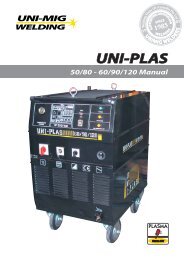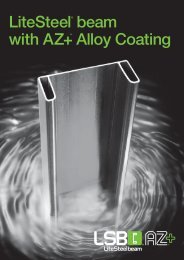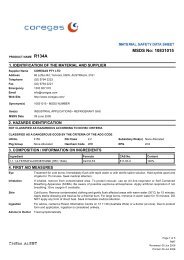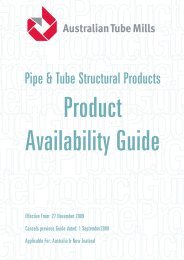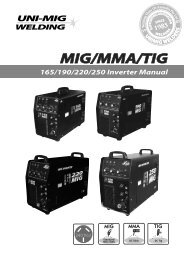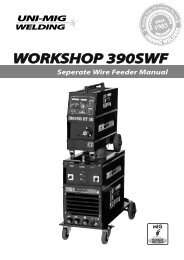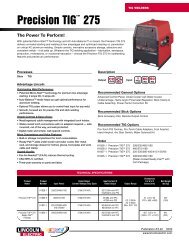Weldmatic 175 [internal wirefeeder] - BJH
Weldmatic 175 [internal wirefeeder] - BJH
Weldmatic 175 [internal wirefeeder] - BJH
You also want an ePaper? Increase the reach of your titles
YUMPU automatically turns print PDFs into web optimized ePapers that Google loves.
<strong>Weldmatic</strong> <strong>175</strong>Establishing a Weld SettingOnce the consumable wire type, wire sizeand shielding gas have been chosen, the twovariables that are adjusted in order to obtaina the desired weld setting are;• Wirefeed speed,• Welding arc voltage.The Weld Setting Charts in Figure 4 can beused to preset the machine for an approximatewelding current. For each of the combinationsof voltage control switch settings, there is arange of valid wirespeed settings.The wirefeed speed determines the weldingcurrent; increasing the speed increases thecurrent, and decreasing it decreases current.The selected wirefeed speed must bematched with sufficient arc voltage; a speedincrease requires an increase of arc voltage.If the voltage is too low the wire will stuband stutter, and there will not be a steadyarc. If the voltage is too high the arc will belong with metal transfer occurring as a seriesof large droplets.Important: Do not operate the VoltageControl switches during welding.The weld setting should be chosen to suit theapplication and the thickness of the metal tobe welded. It is important to check that thedeposited weld provides sufficient strengthto suit the application.A “good” weld will have the characteristicsillustrated in Figure 5. The weld has penetratedinto the parent metal, fusing the root of thejoint where the two plates meet, and the weldblends smoothly into the side walls.A “bad” weld is shown in Figure 6. The weldhas not penetrated the joint root, and thereis poor side wall fusion. This lack of fusionwould normally be corrected by increasingthe arc voltage, or by increasing bothwirefeed speed and arc voltage to achieve ahigher current weld setting.Gun PositionFig 5 “Good” WeldFig 6 “Bad” WeldFor “down hand” fillet welding with gasshielded solid wires, the gun is normallypositioned as shown in Figure 7a below, withthe nozzle end pointing in the direction oftravel.For “down hand” fillet welding withgasless flux cored wires, the gun is normallypositioned as shown in Figure 7b below,with the nozzle end pointing away from thedirection of travel, referred to as ‘dragging’the weld. Gasless flux cored wires should beModel No CP122, Iss A 07/07 13


![Weldmatic 175 [internal wirefeeder] - BJH](https://img.yumpu.com/48683580/15/500x640/weldmatic-175-internal-wirefeeder-bjh.jpg)


